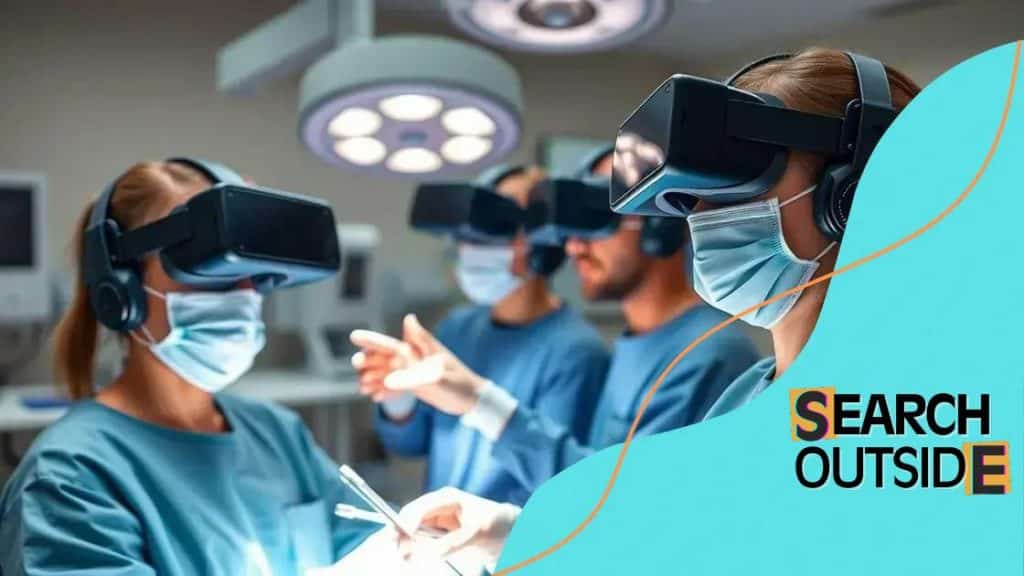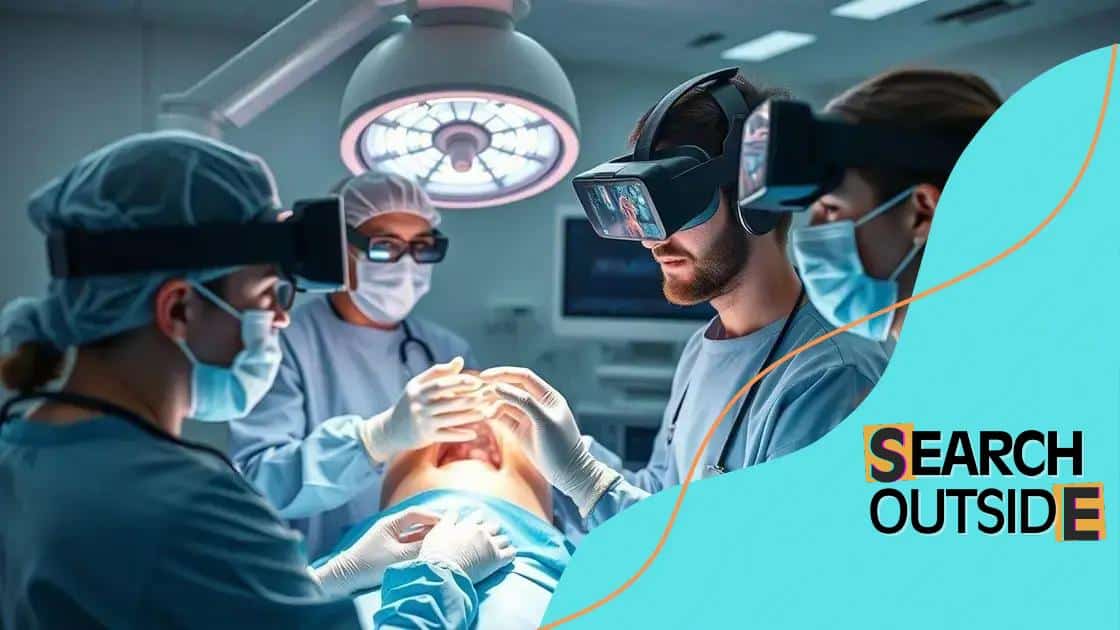How VR technology is used in medical education

VR technology is transforming medical education by providing immersive, hands-on training experiences that enhance skill acquisition, improve learning outcomes, and prepare future healthcare professionals for real-world challenges.
How VR technology is used in medical education has become a game-changer for training healthcare professionals. By simulating real-world scenarios, students can gain invaluable hands-on experience. Curious about how this technology is shaping the future of medicine?
Understanding VR technology in healthcare
Understanding VR technology in healthcare is essential to grasp its transformative potential. This innovative approach leverages immersive experiences to enhance medical education and practice. By engaging learners through realistic simulations, VR offers a unique way to acquire vital skills.
What is VR Technology?
At its core, VR technology creates a simulated environment that users can interact with. It mimics real-world scenarios, providing a safe space for practice without real-life risks. Healthcare professionals can benefit tremendously from this immersive training method.
Key Benefits of VR in Healthcare
- Safe training environment for practicing procedures.
- Immediate feedback on performance.
- Enhanced retention of knowledge through practical experience.
The use of VR doesn’t just stop with training. It can also be used for patient treatment—helping patients with phobias or anxiety disorders. Through controlled environments, patients can face their fears gradually.
Moreover, VR technology can facilitate remote surgeries, allowing surgeons to practice complex procedures from anywhere. By using VR, they can improve their techniques and develop confidence before performing on actual patients. This is a significant advancement in surgical training that promises to enhance patient outcomes.
Challenges of VR Technology
Despite its many advantages, there are challenges to the adoption of VR technology in healthcare. High costs for quality VR systems can be a barrier for some institutions. Additionally, not all medical professionals are familiar with VR, which can hinder its effective implementation.
Nonetheless, as technology advances and becomes more accessible, the integration of VR into healthcare continues to grow. Understanding its scope and challenges is crucial for educators and future medical practitioners.
Benefits of VR for medical students
The benefits of VR for medical students are substantial, changing the way they learn and develop skills. By immersing students in realistic scenarios, VR enhances their educational experience in ways traditional methods cannot.
Hands-On Experience
VR provides a hands-on learning experience that is crucial for medical training. Students can practice complex procedures in a risk-free environment. This type of learning can lead to greater confidence and competence when they enter their clinical rotations.
Immediate Feedback
With VR technology, students receive immediate feedback on their performance, which is essential for improvement. Instructors can track progress and make adjustments as needed, ensuring that students are prepared for real-life situations.
- Promotes active learning.
- Encourages retention of information.
- Simulates high-pressure situations for real-time learning.
Another advantage of VR is accessibility. Students can access training modules anytime, anywhere. This flexibility allows them to learn at their own pace, revisiting areas where they feel less confident.
Additionally, VR technology can foster collaboration among students. They can work together in virtual environments, discussing strategies and sharing insights just like they would in real-life work situations. This enhances teamwork skills, which are vital in healthcare settings.
Reducing Anxiety
For many students, the transition from classroom learning to clinical practice can be stressful. VR helps alleviate some of that anxiety by allowing them to practice in a supportive and controlled setting. Students can familiarize themselves with procedures and environments before encountering them in real life.
In conclusion, the benefits of VR for medical students extend far beyond traditional education. By combining immersive experiences with practical training, students are better prepared for their future roles as healthcare professionals.
Practical applications of VR in training

The practical applications of VR technology in training are vast and continually expanding. VR provides immersive experiences that allow learners to practice skills in a controlled environment. This method is particularly valuable in fields where hands-on experience is crucial, such as medicine.
Medical Training
In medical education, VR enables students to conduct virtual surgeries and practice procedures. They can simulate patient interactions, helping them to develop their communication and diagnostic skills without endangering real patients. This approach reduces the risk of mistakes while fostering a deeper understanding of anatomy and medical procedures.
- Practice complex surgeries in a realistic setting.
- Enhance patient interaction skills through simulations.
- Receive real-time feedback on performance.
Another application is in emergency response training. First responders can use VR technology to simulate high-pressure situations like natural disasters or medical emergencies. This training prepares them to make quick decisions and practice teamwork under stress, which is invaluable in real-life scenarios.
Skills Development in Other Fields
Beyond healthcare, VR has applications in various industries. For instance, manufacturing workers can learn to operate complex machinery through immersive simulations. This hands-on training ensures they understand the equipment and safety protocols before working in a real environment.
Additionally, the military utilizes VR technology for tactical training. Soldiers can experience combat situations without the dangers associated with live training exercises. This allows them to refine their strategies in a safe environment, ultimately improving their readiness.
As we explore the benefits of VR, it’s clear that its applications in training are game-changing. By creating realistic training environments, VR not only enhances learning but also prepares individuals for real-world challenges.
Challenges of implementing VR in education
The challenges of implementing VR technology in education can be significant but are important to address. Despite its many benefits, the integration of VR into training programs poses several hurdles.
Cost of Technology
One major challenge is the high cost associated with VR systems. Purchasing hardware and software can strain budgets, particularly in schools and institutions that already face financial constraints. This can limit access to VR tools for both students and educators.
Technical Expertise
Another issue is the need for technical expertise. Educators may not be familiar with VR technology, making it harder to integrate effectively into the curriculum. Without proper training, the potential of VR can go untapped. Professional development is crucial for teachers to become comfortable using new technologies in their classrooms.
- Need for ongoing training on VR tools.
- Staff may resist adopting new technologies.
- Ensuring reliability of VR systems during classes.
Moreover, creating relevant content for VR lessons can be time-consuming and requires specialized skills. Schools often lack resources to develop high-quality VR content, which can hinder implementation.
Equity and Accessibility
Equity is also a concern; not all students may have equal access to VR technology. Some may miss out on immersive learning experiences due to disparities in technology availability. Addressing this gap is vital to ensure all students benefit from advanced educational tools.
In summary, while VR technology holds great promise for education, overcoming these challenges will be essential for its successful implementation. Schools and institutions must work collaboratively to address costs, training needs, and accessibility to harness the full potential of VR.
The future of VR in medical training
The future of VR technology in medical training looks bright and full of potential. As advancements in technology continue, the integration of VR in medical education is expected to expand significantly. This will enhance how healthcare professionals learn and practice skills.
Immersive Learning Experiences
One of the most exciting aspects of the future of VR in medical training is the creation of even more immersive learning experiences. Medical students will be able to interact with 3D models of human anatomy and practice procedures in a virtual environment. This kind of interactive learning can boost retention and understanding.
Personalized Training Programs
Additionally, VR technology could lead to personalized training programs tailored to the needs of individual learners. By analyzing performance data, VR can adjust training scenarios to focus on areas where a student needs improvement. This adaptive learning approach can accelerate skill acquisition.
- Targeted practice for specific medical conditions.
- Real-time assessments of student performance.
- Customization of learning paths based on strengths and weaknesses.
As remote learning becomes more prevalent, VR technology will enable students to participate in training from anywhere in the world. This accessibility can democratize medical education, allowing more aspiring healthcare providers to receive quality training regardless of their location. In rural or underserved areas, this technology can provide essential training resources that may not otherwise be available.
Innovative Assessment Methods
The assessment of students’ skills may also become more sophisticated with VR. Instead of traditional exams, students might demonstrate their abilities in virtual scenarios, receiving immediate feedback based on their actions. This will not only make assessments more engaging but also provide a clearer picture of a student’s readiness for real-life medical challenges.
As we look ahead, it’s clear that the future of VR technology in medical training holds incredible promise. By enhancing educational experiences and increasing accessibility, VR will likely shape how future healthcare professionals are trained and prepared for their vital roles in society.
In conclusion, the integration of VR technology in medical training is reshaping how healthcare professionals learn. With its immersive capabilities, VR enhances education, supports hands-on practice, and offers personalized learning experiences. As we move into the future, addressing challenges like cost and accessibility will be crucial. Ultimately, embracing VR can lead to better-trained medical professionals and improved patient care.
\n\n\n
\n
\n
FAQ – Frequently Asked Questions about VR in Medical Training
What is VR technology in medical training?
VR technology allows medical students to practice skills in immersive, simulated environments, enhancing their learning experience.
How does VR improve hands-on experience for students?
By enabling realistic simulations, VR allows students to perform procedures without risking patient safety, helping them gain confidence and competence.
What are some benefits of VR for medical education?
Benefits include personalized training programs, immediate feedback on performance, and increased accessibility to training resources.
What challenges exist for implementing VR in medical training?
Challenges include high costs, the need for technical expertise, and ensuring equitable access to VR technology for all students.





